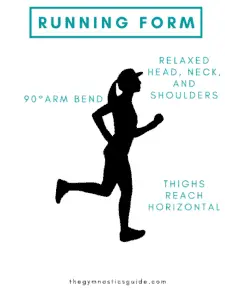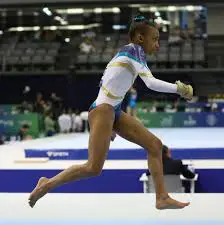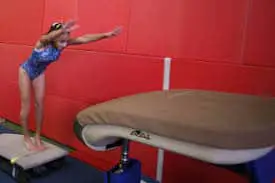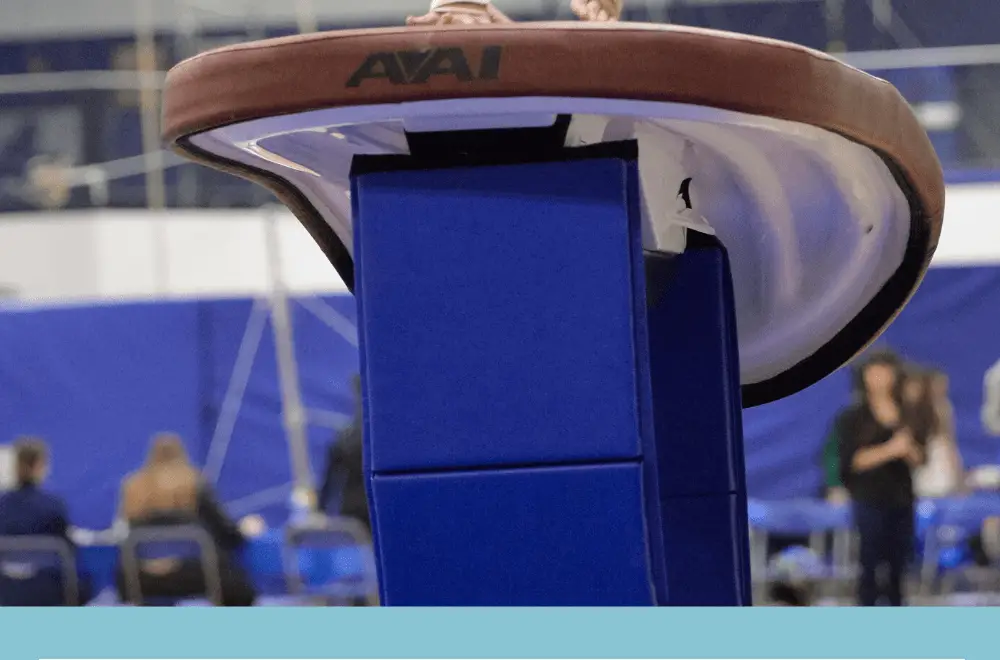Everyone wants a big, powerful, vault. At first glance, vault seems like the easiest event to master. It’s only one skill – how hard could it be? But it’s not as easy as it sounds. Many gymnasts are missing the key ingredient to a great vault: a powerful vault run.
Why is the run important?
But the judges don’t deduct for the run, right? Why do I even need to run fast?
Great questions! It’s true that, at most levels, the judges do not deduct for errors during the run and approach. Judging officially starts when the gymnast leaves the board.
However – this does not mean that the run doesn’t matter. A strong run is essential to a great vault. Here’s why.
In order for the gymnast to get over the vault table, she needs to be able to get her feet over her head quickly. Otherwise, she will just fall back the way she came. The run helps the gymnast to generate the power to get over the table.
Think of the vault like a set of dominoes. Each domino, in turn, knocks down the next domino in the series. The first domino in the series is the run. The next domino is the hurdle, then the punch off the springboard. The final domino is the block off the vault table.
Here’s how it works.
The speed from the run turns into upward momentum after the gymnast hurdles and hits the springboard. Then, the block from the table transforms the momentum into height and distance. Setting that first domino (the run) into motion will, in turn, set the next dominoes into motion. Without “knocking down” that first domino (a strong run), the next dominoes (the hurdle onto the springboard and the block) will not generate the desired height and distance, and the vault will fall flat.
What does a good vault run look like?

The best vault runs are efficient. If the gymnast runs efficiently, she will use less energy while running. This means that she will be able to perform her vault more easily, and complete more repetitions before she gets fatigued.
An efficient vault run has a slight forward lean. The gymnast’s elbows should be bent to 90°. The elbows should move directly forward and backward. The knees should come up until the thighs are parallel to the ground. The head should be neutral, with the shoulders, face, and neck relaxed.
Drills can (and should!) be performed to improve all components of the running technique. Keep reading to find information on some good running drills!
Deductions for vault run

As stated earlier, at most levels, there is no deduction specifically designated for the quality of a gymnast’s run.
However, some of the lower levels do have run deductions. Levels 2 and 3 have three different deductions for the run and approach.
Failure to accelerate (Up to 0.30)
This deduction is exactly as it sounds: the gymnast must show acceleration between the beginning of her run and the time when she reaches the springboard. This deduction is, admittedly, a bit subjective. The judges must determine whether the gymnast has reached her maximal running speed.
When I am evaluating a gymnast’s running speed, I am looking to see her run progressively gain speed. The run should look like a sprint by the end of the runway. If it’s hard to tell if the run is fast enough, ask these questions:
- Does the run get consistently faster as the gymnast progresses down the runway?
- Is the gymnast sprinting at her top speed?
- Is the run fast enough for the gymnast to get a handspring vault over the table?
I can usually tell if the vault will be good by watching the gymnast’s run. I bet, if you watch a number of gymnasts run, you’ll be able to tell the differences, too!
Failure to maintain horizontal running speed (Up to 0.30)
The acceleration gained in the early part of the run should be maintained all the way to the springboard. Sometimes, the run will slow down as the gymnast approaches the board. This may happen due to fear, the gymnast’s steps being off, or thinking ahead to the vault too much. It’s important to identify the cause in order to make a positive change.
Deductions can be taken for a few different errors in maintaining speed. First, a deduction can be taken for stutter-steps prior to board contact. If the gymnast takes several short, stuttering steps before she reaches the board, this deduction would be applied. The deduction also applies if the gymnast takes long, leaping steps before the board. Finally, the deduction is taken if the run simply slows down toward the end, regardless of the quality of the steps.
Forward lean on springboard (Up to 0.30)

The final deduction for the Level 2/3 run is not technically for the run, but for the body position on the springboard. The gymnast should complete her run with a hurdle, landing on the springboard with both feet at the same time. Some coaches teach an arm circle as part of the hurdle. Personally, I’ve always been a fan of the arm circle. The backward arm circle promotes good posture by keeping the chest up, and it also allows the gymnast’s arms to naturally rise as she begins her preflight. Two wins for body position!
The ideal body position on the board is upright, with the chest leaning slightly backward upon board contact. The slight backward lean allows the forward momentum from the run to translate into upward momentum as the gymnast begins to invert. A common error is leaning forward on the board while the gymnast reaches for the vault table. This forward lean can result in an up to 0.30 deduction in a Level 2/3 vault, and it will also lead to poor body position (pike) during the vault. Hurdle and board drills are key in teaching body position on the board.
The Different Vault Approaches
As the gymnast enters Level 6 and above, there are three different approaches she might use to begin her vault. The approach is different for each of these three techniques.
Forward entry
Forward entry vaults comprise Groups 1 and 2 of the Level 8-10 vault charts. Group 1 consists of handspring vaults and twisting vaults. Group 2 consists of forward-entry salto vaults. The gymnast will perform the same run and entry as she would in a compulsory vault during these types of vaults.
Tsukahara entry
Tsukahara-style vaults are in Group 3 of the Level 8-10 vault chart. The corresponding Level 6/7 vault is the 1/2 on timer. For these vaults, the gymnast will run just like before, and after she hits the springboard, she will perform a 1/2 twist onto the vault table.
Yurchenko entry
Yurchenko vaults comprise Groups 4 and 5 of the Level 8-10 vault chart. Group 4 consists of Yurchenko-style vaults, and Group 5 consists of roundoff half-on vaults. The big difference in approach for the Yurchenko family is that the gymnast will perform a roundoff onto the springboard and a back handspring onto the vault table.
Drills to improve your vault run
Some basic drills for the run are:
- Standing/seated arm position practice
- High knee runs
- Heel kicks
- Deer runs
- Hurdle and arm swing drills
- Sprints
Check out Swing Big for some tips and drills for the vault run.
Simone Biles’ masterclass also has a section with a video showing some good vault running drills.
Do you have any favorite drills for the vault run? Drop them in the comments!
Further Reading
Here are some more articles to help you improve your vault:
5 Tips for a Stellar Handspring Vault
Xcel Vault: What You Should Know
Tips and Resources to Boost Your Level 6/7 Vault Score
Resources: USA Gymnastics J.O. Compulsory Handbook, 2021-2029
